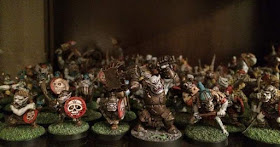Those are big numbers. OK, there's a note suggesting that the referee "increase or decrease according to party numbers" and that the figures are "primarily for outdoor encounters". Still - increase?
By BECMI, we're down to 2d8 goblins - or 6d10 in their lair - and 2d4 (or 1d6 x 10) orcs. But AD&D retains the big numbers.
I wonder if these figures were often or ever used in the Gygax/Arneson games. Perhaps they were: they would link nicely with Chainmail and the wargame side of things. I can see rows of Airfix Romans with the Red Eye painted on their shields. Or perhaps these numbers were just stuck in to add a sort of anthropological verisimilitude.
But whatever their origins, the numbers do suggest a game that's less about the succession of skirmishes suggested by the BECMI numbers and more about avoidance. If there really are 300 orcs in the mines, you don't want to meet any of them - and certainly not if they have horns to blow or drums to beat.
Doom! Doom!
Of course, Tolkien's Moria is in many ways the prototypical "dungeon". But while the Fellowship fight plenty of orcs and encounter trolls and the balrog too, that wasn't the idea. They wanted to get through without attracting the attention of any lurking goblins - or worse. And they pay a heavy price for failing to do so.
I thought about all this when playing a new skirmish game, Sellswords & Spellslingers, from Ganesha Games with my kids and some friends. It's a cooperative game, so the players - each of whom controls a small number of PCs - are pitted against monsters controlled by a deck of cards. As character progression and loot are important, the author suggests it can work as a sort of RPG-lite. And it does: the wandering monsters and random events add a fair bit of surprise, and the "accomplish aims vs loot the corpses" dynamic creates a lot of tension.
What I liked most about it, though, was the way that the game tends to flood the table with monsters. We went through at least 50 orcs both times we played the first scenario in the book, and only a few PCs survived each time; the dead, admittedly, were victims of their own avarice as much as of the orcs.
That opening scenario has an explicit escape theme, and I think that's a natural fit for full-blown RPGs: yes, there are 200 gnolls in here. And no, they won't be waiting in rooms in isolated groups of two or three. So you'd better move fast and leave few traces, because you don't want them on your trail. Oh - and do something to muffle your scent!

That's quite sensible, to have a "total" number of enemies. On one size, the party needs to avoid direct confrontation. On the other, recruiting mercenaries, stirring up villagers into a militia, or simply ambushing smaller groups is always an option. Monsters, anyway, are rational creatures and, once a good number of them is dead or missing, they might decide either to negotiate or leave.
ReplyDeleteTheoretically - I always thought it but never really did it - an RPG can switch to a wargame to solve some situations. That's one of the reasons I like WFRP - converting to WFB is straightforward!
Yes, indeed - one of the things I've been planning to do for a long time is have a campaign that involves Hordes of the Things for big battles and an RPG system for a "zoomed-in" look at what happens - for example - when the Black Legion captures the ruined keep outside the village in the course of a battle.
ReplyDelete